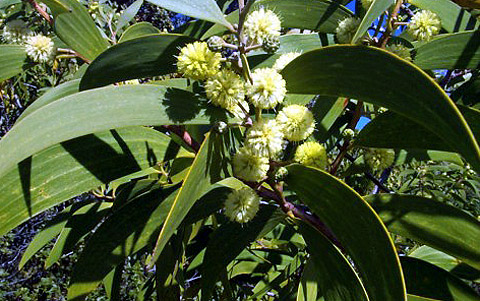Birds
and Plants of Kauai:
The Koa Tree
by Linda Pascatore on 6 August 2006
The Koa Tree (Acacia Koa) is a large, evergreen broadleaf tree which
is endemic to Hawaii (evolved in the Hawaiian islands and is not
naturally occurring anywhere else). It is a rain forest canopy tree,
found from 600 to 7000 feet elevation on all of the main Hawaiian
islands. It is often found with Ohia trees, but the species can
dominate the rain forest and form a continuous canopy at higher
elevations.

Iimmature koa tree leaves have feathery leaves
The Koa is one of the tallest Hawaiian trees, and can stand over
100 feet tall, with a canopy spreading 40 to 80 feet. The sickle
shaped leaves of the koa are actually modified petioles or phyllodes.
These leaves help the tree resist drought. The koa sapling has feathery
true leaves, with some older saplings showing both types of leaves.
The true leaves are responsible for quick growth of the young trees.
Koa flowers are small fuzzy yellow balls with no petals.|

mature koa tree leaves (actually petioles) are crescent shaped
The koa is a valuable participant in the native rain forest habitat.
It is a nitrogen-fixing species that enriches the forest floor and
feeds other plant species. It is considered to be one of the oldest
Hawaiian trees, and it supports over 40 species of endemic insects.
Many native bird species are associated primarily with the Koa tree.
Koa wood is much in demand. The ancient Hawaiians used the tree
for making canoes and surfboards, as well as for paddles, containers,
weapons and tools. Dugout canoes were made from a single Koa trunk
of this salt water-resistant wood. Koa bark was used to dye tapa
cloth. The Koa was used by native Hawaiians for a variety of medicinal
purposes, including birth control.

koa grain can be wavey in one direction and rippled in another
Today the wood is valued by woodworkers, who craft beautiful cabinets,
furniture, and bowls. Koa is known as the Hawaiian mahogany, and
it can be polished to a warm sheen. The wood often has an interesting
curly grain, and the rich colors range from golden blonde through
orange-red to deep purple.
The Koa is a protected species. It has suffered from overlogging
and from the clearing of land for grazing cattle. Only dead trees
may be taken by permit for woodworking, except for farmed Koa. It
takes fifty years for a Koa to mature to the point where it is useful
for furniture making.
Koa does not regenerate where cattle are present, but when they
are removed, it is one of the few native Hawaiian trees capable
of germinating in grassland. Therefore the species has been used
to help restore native forests. At the Halakau Nation Wildlife Refuge,
it was shown that Ohia survives best when planted under Koa trees.
Although most Koa currently grows on the slopes of the Big Island
and Maui, you can find rain forest areas with Koa trees in Kokee
State Park on Kauai. The most accessible areas are along the Pihea
and Alakai Swamp trails.
|





